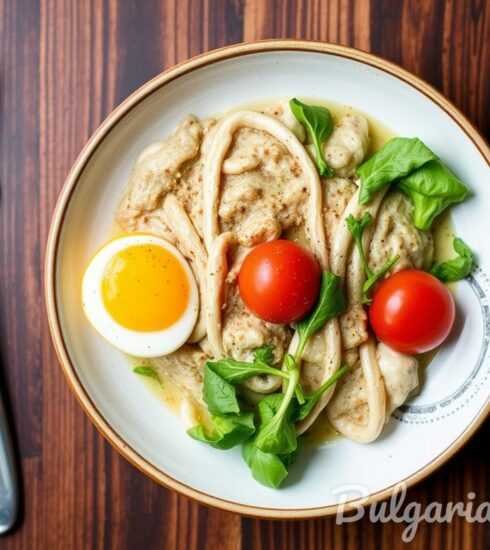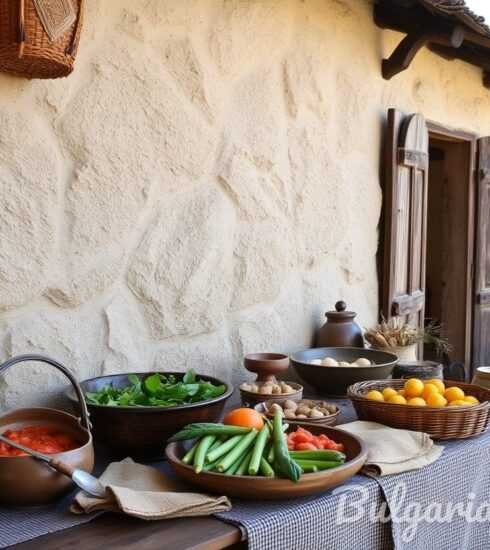Unlocking the Hidden Flavors of Bulgarian Delights: A Succulent Culinary Guide
Bulgarian Delights: Unlocking the Hidden Flavors of Local Cuisine
Bulgaria, a picturesque country located in Southeast Europe, has a rich culinary heritage that spans over centuries. The cuisine of this beautiful nation is a unique blend of flavors, techniques, and traditions that have been handed down through generations. Authentic Bulgarian cuisine is a true reflection of the country’s culture, history, and geography. In this culinary guide, we will take you on a gastronomic journey through the hidden flavors of Bulgarian cuisine, uncovering the secrets of its most beloved dishes.
The Influence of Geography on Bulgarian Cuisine
Located at the crossroads between Europe, Asia, and the Middle East, Bulgaria has been influenced by a diverse range of culinary traditions. The country’s cuisine is a fusion of flavors that are a result of both historical factors and geographical location. The rich agricultural land, fertile valleys, and vast coastlines have all played a role in shaping the ingredients and cooking methods used in Bulgarian cuisine.
- Mediterranean Influence: The proximity to the Mediterranean Sea has left a lasting impact on Bulgarian cuisine. Olive oil, fresh vegetables, herbs, and seafood are all staples in the coastal regions of the country.
- Ottoman Influence: Bulgaria was once part of the Ottoman Empire, and this period had a significant influence on the country’s culinary traditions. The Ottoman Turks introduced various spices, cooking techniques, and dishes such as stuffed peppers and baklava.
- Balkan Influence: The Balkan region, which Bulgaria is a part of, has its own distinct culinary traditions. Grilled meats, hearty stews, and fermented dairy products are common in Balkan cuisine and can be found in many Bulgarian dishes.
Traditional Bulgarian Dishes
Now let’s dive into the delicious world of authentic Bulgarian cuisine and explore some of the most iconic dishes that you must try during your visit to this enchanting country:

1. Banitsa
Considered the quintessential Bulgarian dish, Banitsa is a savory pastry made from layers of phyllo dough, eggs, and cheese. This flaky delight is traditionally prepared for special occasions and is often enjoyed as a breakfast or a snack. The cheese used in Banitsa can vary, with white brined cheese being the most popular choice. However, other fillings such as spinach, mushrooms, or pumpkin can also be used. Banitsa is best enjoyed fresh out of the oven, with a cup of Bulgarian yogurt.
2. Shopska Salad
A refreshing and colorful Bulgarian salad, Shopska Salad is a blend of fresh tomatoes, cucumbers, peppers, onions, and white brined cheese. This vibrant dish is a popular appetizer and is often served as a starter in Bulgarian restaurants. The combination of juicy tomatoes, crisp cucumbers, and tangy cheese creates a harmonious medley of flavors. Shopska Salad is typically dressed with a drizzle of olive oil and a sprinkle of dried oregano.
3. Tarator
Tarator is a cool and creamy Bulgarian soup that is perfect for hot summer days. This refreshing dish is made with yogurt, cucumbers, garlic, dill, and walnuts. The ingredients are blended together to create a smooth and silky texture. Tarator is typically served chilled and garnished with fresh herbs. It is a popular dish in the Balkan region and is loved for its refreshing taste and nourishing properties. It is also a fantastic accompaniment to grilled meats.
4. Kapama
Kapama is a hearty stew that is traditionally prepared in a clay pot. This slow-cooked dish is made with a combination of pork, beef, or chicken, along with sauerkraut, onions, peppers, and spices. The ingredients are layered in the pot and cooked over low heat for several hours, allowing the flavors to meld together. The result is a rich and comforting stew that is bursting with flavor. Kapama is a popular dish during the winter months and is often enjoyed with a glass of Bulgarian red wine.

5. Patatnik
Patatnik is a traditional Bulgarian dish that originated from the Rhodope Mountains. It is a potato and cheese bake that is typically prepared in a skillet. The dish is made by grating potatoes and mixing them with eggs, onions, spices, and white brined cheese. The mixture is then cooked until it forms a crispy golden crust. Patatnik is a delicious and hearty dish that is perfect for a comforting meal on a cold day.
6. Kavarma
Kavarma is a flavorful Bulgarian dish that is similar to a stew. It is made with a combination of meat, typically pork or chicken, along with onions, peppers, tomatoes, and spices. The ingredients are slow-cooked together, allowing the flavors to meld and develop. Kavarma is a popular dish during celebrations and is often enjoyed with a glass of rakia, a traditional Bulgarian distilled spirit.
7. Bulgarian Yogurt
No culinary guide to Bulgarian cuisine would be complete without mentioning Bulgarian yogurt. Known for its thick and creamy texture, Bulgarian yogurt is made with a specific strain of lactobacillus bulgaricus bacteria, which gives it its distinctive taste and texture. Bulgarian yogurt is a staple in Bulgarian households and is enjoyed on its own, as a topping for dishes, or as an ingredient in various recipes. It is also believed to have numerous health benefits and is known for its probiotic properties.
Where to Experience Authentic Bulgarian Cuisine
If you’re looking to explore the diverse flavors of Bulgarian cuisine, there are numerous restaurants and culinary experiences that offer an authentic taste of the country’s culinary heritage. Here are a few recommendations:

- Restaurant Hadjidraganov’s Houses: Located in the heart of Sofia, this traditional Bulgarian restaurant offers a wide selection of authentic dishes in a charming setting. The menu features classic Bulgarian dishes such as Banitsa, Shopska Salad, and Kavarma.
- Melnik Winery: Situated in the famous wine region of Melnik, this winery not only offers exceptional Bulgarian wines but also traditional Bulgarian cuisine. Visitors can enjoy dishes such as Kapama, Patatnik, and Kavarma, paired with delicious local wines.
- Plovdiv Old Town: The historic Old Town of Plovdiv is home to numerous restaurants and cafes that serve traditional Bulgarian cuisine. Visitors can explore the cobblestone streets while sampling dishes such as Banitsa, Tarator, and Bulgarian Yogurt.
To truly immerse yourself in the world of Bulgarian cuisine, consider booking a culinary tour or cooking class. These experiences allow you to learn about the country’s culinary traditions, interact with local chefs, and even try your hand at preparing traditional Bulgarian dishes.
Conclusion
Bulgarian cuisine is a hidden gem that is waiting to be discovered. From the flaky layers of Banitsa to the refreshing flavors of Tarator, every dish tells a story and offers a glimpse into the rich culinary heritage of this beautiful country. Whether you’re a food lover, a history enthusiast, or an adventurous traveler, exploring the flavors of authentic Bulgarian cuisine is an experience that should not be missed. So, pack your bags, embark on a culinary adventure, and unlock the hidden flavors of Bulgarian delights.
For more information on Bulgarian cuisine and culinary experiences in Bulgaria, check out the following articles:
- An article available at https://bulgaria-trip.fun/culinary-guide/bulgarian-cuisine/. This article provides an in-depth overview of Bulgarian cuisine, including its history, ingredients, and popular dishes.
- An article available at https://bulgaria-trip.fun/culinary-guide/bulgarian-delicacies/. This article highlights some of the most delicious and unique delicacies that you can try during your visit to Bulgaria.
Experience the flavors of Bulgaria and enhance your culinary journey with these informative articles!






